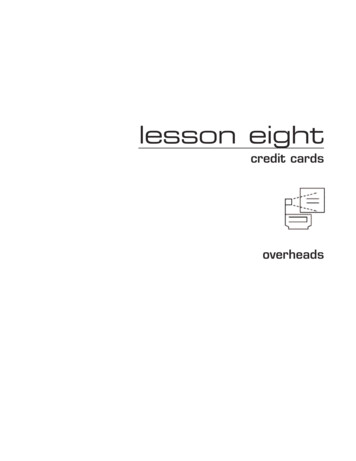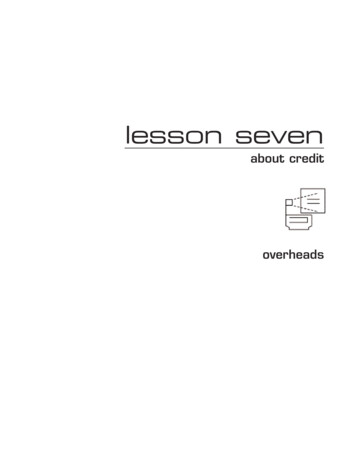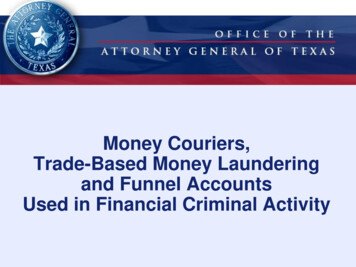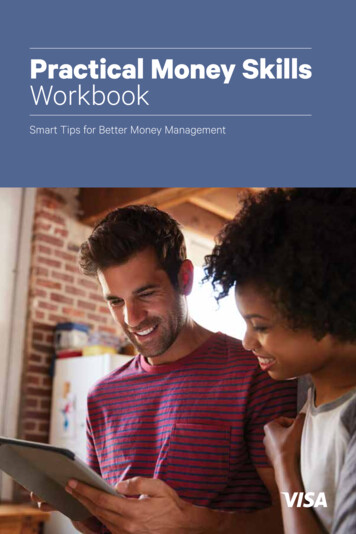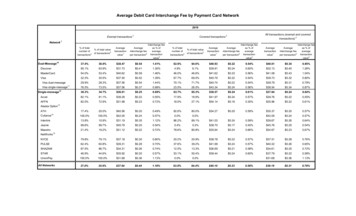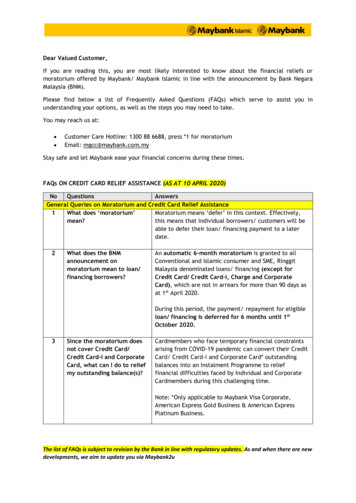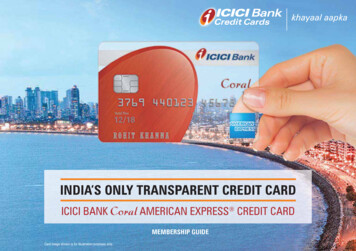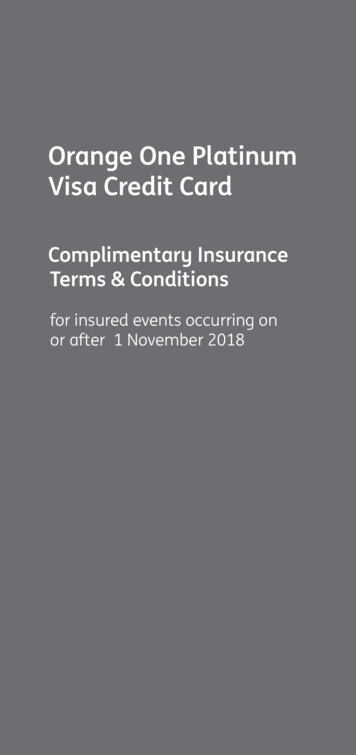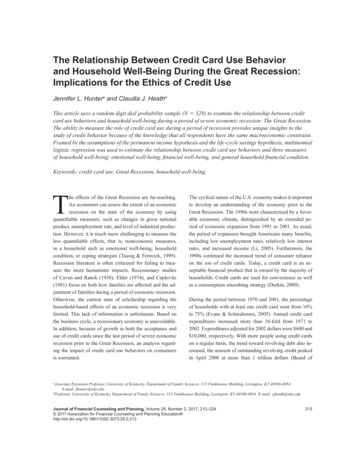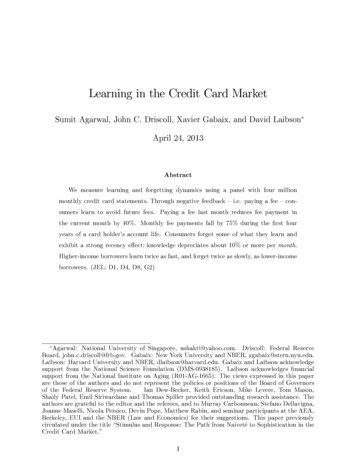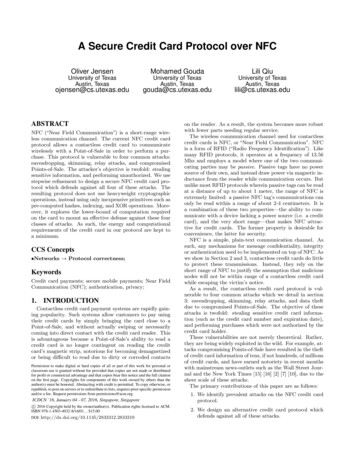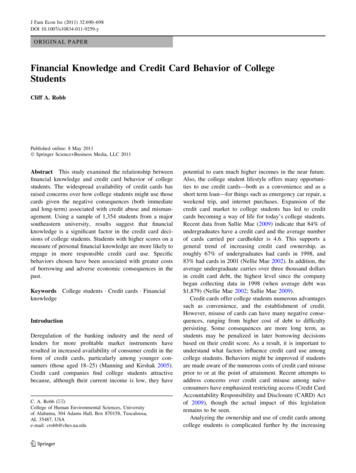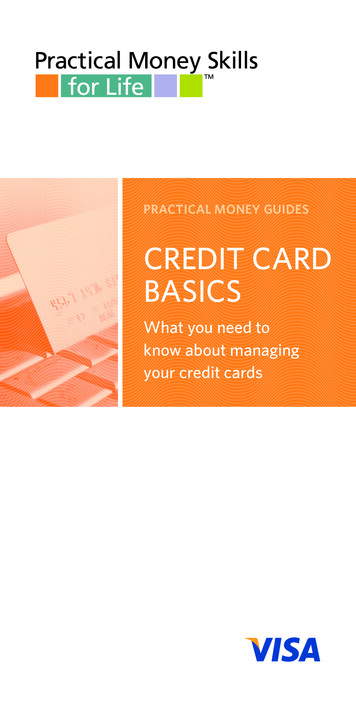
Transcription
PRACTICAL MONEY GUIDESCREDIT CARDBASICSWhat you need toknow about managingyour credit cards
WHERE TO TURN FOR HELP WITHDEBT MANAGEMENTThere’s help available when you’re in trouble. If youthink you’re falling seriously behind, credit counselingresources are available at little or no cost.TAKE CHARGE WHEN YOU CHARGENATIONAL FOUNDATION FOR CREDIT COUNSELING1.800.388.2227www.nfcc.orgTHE FEDERAL TRADE umer/credit/debt.shtmAMERICAN CONSUMER CREDIT TICAL MONEY GUIDESCREDIT CARDBASICSCredit cards can be powerful financial tools for you and your family, and as with all financialtools, they need to be used carefully. This guide outlines the basics of credit cards and theresponsible use of credit.What you need toknow about managingyour credit cardsPRACTICAL MONEY GUIDESBUDGET BASICSCREDIT HISTORYCREDIT CARD BASICSDEBIT CARD BASICSFor more information, visitwww.practicalmoneyskills.com 2009 Visa Inc.VPMSFL09INSRTCBPREPAID CARD BASICSIdentity TheftWhen you understand how to manage your finances, you’ve got aninvaluable tool in taking control of your life. Wise use of these skills canprovide peace of mind, financial freedom, increased buying power anda secure future. This guide is one of a series on PRACTICAL MONEYSKILLS FOR LIFE.
Write it OutTHE CONVENIENCE OF CREDITCredit cards offer many features. There is the convenience of being able to buy needed items now and the security of nothaving to carry cash. You also receive fraud protection and in some cases rewards for making purchases.With these advantages also come responsibilities. You need to manage credit cards wisely by understanding allof the card’s terms and conditions; staying on top of payments; and realizing the true cost of purchases made with§ nnual Percentage Rates (APRs) and whetherArates are fixed or variable§§§§Annual, late and over-limit feesCredit limit on accountGrace periods before interest begins accruingRewards including airline miles or cash backStay AlertSome credit card issuers offer free, personalized andautomatic alert messages to your phone and email tohelp you keep track of:§§§§§ Available credit Balances Payment due dates Payment histories Purchase activityIf you don’t pay off your credit card balance everymonth, the interest assessed on your account meansyou may be paying more than you expect. See howmuch extra you might pay on a 1,000 credit cardpurchase with varying interest rates.Understand Your RightsCREDIT card apr§ ero liability means you are not responsible forZfraudulent charges when you report them promptly.Then total them up. The numbers will probably makeyou worry, but you’ve already made a positive step.§ In some cases, you have the right to disputepurchases with merchants for unsatisfactoryproducts or services.Think Three YearsMONTHLY paymentpaying interest on that loan.The best way to maximize the benefits of credit cardsis to understand your financial lifestyle – your moneyneeds and wants. Once you determine how you’ll usea credit card, it’s important to understand all of thecard’s features including:The True Cost of CreditCard Purchases§ The lender name§ The amount you owe§ The term of the loan§ The interest rate and feescredit. Using a credit card is like taking out a loan. If you don’t pay your card balance in full each month, you’ll startChoose WiselyDo you actually know how much debt you have? Manypeople don’t. Start by making a list of everything youowe, whether it’s a mortgage, a credit card or evenstudent loans you took for the kids’ education. Thenwrite down:Credit cardholders are entitled to protections:Follow the 20-10 RuleThis general “rule of thumb” helps you understandhow much credit you can afford. Credit cards are loans,so avoid borrowing more than 20 percent of yourannual net income on all of your loans (not includinga mortgage). And payments on those loans shouldn’texceed 10 percent of your monthly net income.Reducing debt is like losing weight. You’re not goingto lose 50 pounds in a month. You need realistic goalsin reasonable timeframes. Same with debt. Mostpeople take four to five years to become debt free.So aim for three years. It’s not too long or too short.Cut and Heal SpendingThe best way to save money is to stop spending it.Cutting spending is the fastest way to reduce debtload. It’s literally like a surgical “cut” of your finances.And once you start healing, you’ll notice that yourattitude, relations with others, emotions and sense ofhumor get better, too.TOTAL purchase amountThe balance due on yourcredit cardThe annual interest rateon your credit cardThe minimummonthly paymentNUMBER of monthsto pay off purchaseamount* 1,000 1,000 1,00010%15%25% 40 40 40293136 126.02 206.50 427.22 1,126.02 1,206.50 1,427.22Time it will take to pay offthe balanceTOTAL finance chargeThe total amount of moneyyou will pay in interest aloneTOTAL costThe final amount you willpay for your purchase* In general, this assumes that your account has no new chargesand that your Annual Percentage Rate does not change.
Write it OutTHE CONVENIENCE OF CREDITCredit cards offer many features. There is the convenience of being able to buy needed items now and the security of nothaving to carry cash. You also receive fraud protection and in some cases rewards for making purchases.With these advantages also come responsibilities. You need to manage credit cards wisely by understanding allof the card’s terms and conditions; staying on top of payments; and realizing the true cost of purchases made with§ nnual Percentage Rates (APRs) and whetherArates are fixed or variable§§§§Annual, late and over-limit feesCredit limit on accountGrace periods before interest begins accruingRewards including airline miles or cash backStay AlertSome credit card issuers offer free, personalized andautomatic alert messages to your phone and email tohelp you keep track of:§§§§§ Available credit Balances Payment due dates Payment histories Purchase activityIf you don’t pay off your credit card balance everymonth, the interest assessed on your account meansyou may be paying more than you expect. See howmuch extra you might pay on a 1,000 credit cardpurchase with varying interest rates.Understand Your RightsCREDIT card apr§ ero liability means you are not responsible forZfraudulent charges when you report them promptly.Then total them up. The numbers will probably makeyou worry, but you’ve already made a positive step.§ In some cases, you have the right to disputepurchases with merchants for unsatisfactoryproducts or services.Think Three YearsMONTHLY paymentpaying interest on that loan.The best way to maximize the benefits of credit cardsis to understand your financial lifestyle – your moneyneeds and wants. Once you determine how you’ll usea credit card, it’s important to understand all of thecard’s features including:The True Cost of CreditCard Purchases§ The lender name§ The amount you owe§ The term of the loan§ The interest rate and feescredit. Using a credit card is like taking out a loan. If you don’t pay your card balance in full each month, you’ll startChoose WiselyDo you actually know how much debt you have? Manypeople don’t. Start by making a list of everything youowe, whether it’s a mortgage, a credit card or evenstudent loans you took for the kids’ education. Thenwrite down:Credit cardholders are entitled to protections:Follow the 20-10 RuleThis general “rule of thumb” helps you understandhow much credit you can afford. Credit cards are loans,so avoid borrowing more than 20 percent of yourannual net income on all of your loans (not includinga mortgage). And payments on those loans shouldn’texceed 10 percent of your monthly net income.Reducing debt is like losing weight. You’re not goingto lose 50 pounds in a month. You need realistic goalsin reasonable timeframes. Same with debt. Mostpeople take four to five years to become debt free.So aim for three years. It’s not too long or too short.Cut and Heal SpendingThe best way to save money is to stop spending it.Cutting spending is the fastest way to reduce debtload. It’s literally like a surgical “cut” of your finances.And once you start healing, you’ll notice that yourattitude, relations with others, emotions and sense ofhumor get better, too.TOTAL purchase amountThe balance due on yourcredit cardThe annual interest rateon your credit cardThe minimummonthly paymentNUMBER of monthsto pay off purchaseamount* 1,000 1,000 1,00010%15%25% 40 40 40293136 126.02 206.50 427.22 1,126.02 1,206.50 1,427.22Time it will take to pay offthe balanceTOTAL finance chargeThe total amount of moneyyou will pay in interest aloneTOTAL costThe final amount you willpay for your purchase* In general, this assumes that your account has no new chargesand that your Annual Percentage Rate does not change.
WHERE TO TURN FOR HELP WITHDEBT MANAGEMENTThere’s help available when you’re in trouble. If youthink you’re falling seriously behind, credit counselingresources are available at little or no cost.NATIONAL FOUNDATION FOR CREDIT COUNSELING1.800.388.2227www.nfcc.orgTHE FEDERAL TRADE umer/credit/debt.shtmAMERICAN CONSUMER CREDIT COUNSELING1.800.769.3571www.consumercredit.comFor more information, visitwww.practicalmoneyskills.com 2009 Visa Inc.VPMSFL09INSRTCB
Credit cards can be powerful financial tools for you and your family, and as with all financial tools, they need to be used carefully. This guide outlines the basics of credit cards and the responsible use of credit. PRACTICAL MONEY GUIDES PRACTICAL MONEY GUIDES For more information, visit www.
